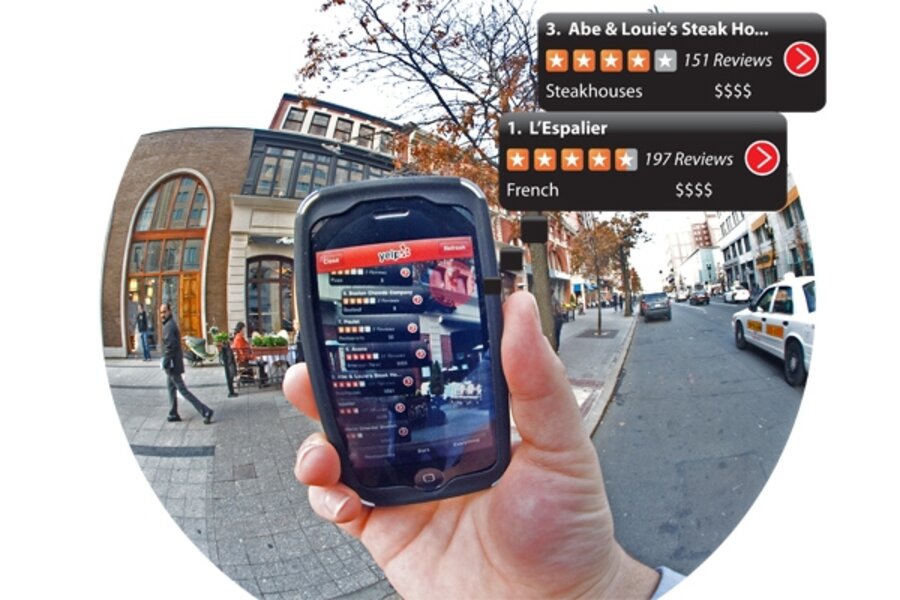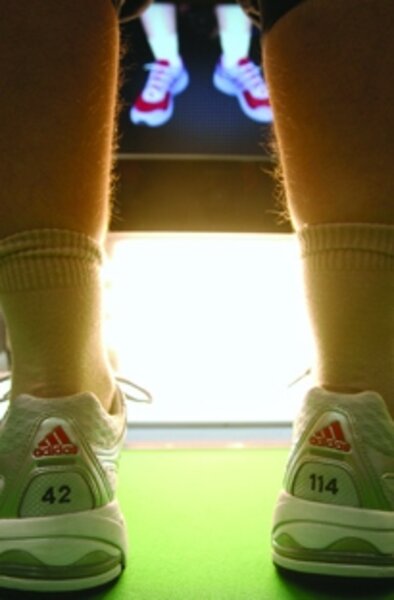Augmented reality: Your world, enhanced
Are you ready to see with “Terminator” eyes? That day may be coming closer.
The Terminator android from the future, as portrayed by Arnold Schwarzenegger in movies, employs enhanced vision that displays data about his surroundings, such as identifying objects, what they are used for, and how they work. “Terminator” vision even identifies people and suggests what to say to them.
This year has seen a huge spike in interest in the concept of “augmented reality” (AR) – the ability to blend data or virtual objects from the Internet with the “real world” we see around us. The question now is whether 2009 will be a tipping point toward a time when AR is routinely all around us, or whether it’s a bubble of overheated hype that pops and disappears.
Perhaps the biggest change driving AR has been widespread adoption of smart phones, such as the iPhone and those based on Google’s Android platform. These devices possess the technology needed to create a simple (some would say primitive) form of AR. By combining video cameras, GPS (global positioning systems), and compasses, smart phones can figure out their own location and in which direction they are being pointed.
That has allowed developers to begin sending virtual data to “augment” what’s displayed by the phone’s camera. Point the camera up a street, for example, and the screen would show the scene with other information “layered” on top, such as restaurant descriptions, where the subway stops are, or which apartments are for rent.
The idea of “augmented reality has been around for a long, long, long time,” says Dana Farbo, president of acrossair.com in New York City. Labs have been tinkering with it for decades. “Heads up” display screens in airplanes and even autos are already in use. Even the yellow “first down” line shown on televised football games is a form of AR – it’s not really on the field, it has been added digitally, augmenting the view.
But now AR is “being unleashed from basement computer labs around the world into the commercial world,” says Ori Inbar, whose Games Alfresco blog tracks developments in the fast-changing AR world.
Acrossair offers an iPhone app that allows users in certain cities to see information about the nearest subway stop when they point their phone in any direction. The app (cost: $1.99) is available for more than a dozen cities, including New York, London, and Tokyo.
But the app doesn’t really “see” the street in front of it. The program simply uses the GPS and compass to figure out where it is and presents information about what its database says is near those map coordinates.
That’s caused some critics to scoff that such apps don’t represent “true” AR, which would recognize what is being seen in the real world by the camera (such as a building or a person) and respond with related virtual content, such as text or images.
“We’re still at the beginning. What we’re doing now is very simple,” says Maarten Lens-FitzGerald, cofounder of Layar.com, based in Amsterdam. Over time, he says, his company will be “adding more tools so people can do more.”
Layar provides a platform for developers to create AR phone apps. The company’s website shows more than 200 phone apps with AR experiences on them. One, for example, displays background information about windmills in Holland when the phone is pointed toward one. In another, tourists wandering the fields of France with smart phones can see an overlay of the locations of World War I trenches, now overgrown and hard to spot, highlighted on their screen.
In Britain, one app identifies the species of trees as people wander through the famous Kew Gardens. In the United States, an In-N-Out Burger app kicks in when one of the popular fast-food restaurants is nearby.
About 400,000 people have downloaded the Layar phone browser (available only for Android-based phones for now) in the past few months, Mr. Lens-FitzGerald says, while more than 1,000 developers are working on new AR “layers” for it.
Esquire magazine’s December issue demonstrates another way of using AR that is also booming – though it, too, is being disparaged by some as a mere gimmick.
When the Esquire cover is viewed by a computer webcam, special software kicks in. Rather than showing the static cover image of Robert Downey Jr., the computer plays a video of the actor talking about his latest film. In an AR feature inside, a fashion model will change his clothes for a new season of the year as a page is held toward the webcam. Show another page to the camera and an actress springs to life on your computer screen to tell a joke. She tells a “naughty” joke if the page is viewed after midnight.
A French company, Total Immersion, has designed football and baseball trading cards for Topps that “come alive” when held up to a computer webcam. When viewed on a computer screen, 3-D versions of the players appear to stand on top of the card and perform some basic movements, mirroring the user’s actions.
Action figures from the new fantasy movie “Avatar,” coming in December, include special tags. When they are held up to a webcam, a 3-D figure of the toy appears on-screen and performs various movements controlled by the user.
Such uses for entertainment and games “are going to be the biggest market” in the near future, Mr.
Inbar predicts.
But more practical uses are on the way, too. In an AR program available online from the US Postal Service, customers hold an object they want to mail up to their webcam. The computer screen displays a virtual mailing box of the appropriate size that appears to surround the object, helping the customer choose the right box.
Still, it’s the long-range potential of AR that continues to hold the most excitement.
William Hurley, known to his fans online as “whurley,” is a longtime AR advocate in the high-tech community. He recently left his tech-industry job to focus full time on developing new AR applications.
One concept, which he calls “massive multiplayer in-world games,” would bring computer games, in the mode of the hugely popular World of Warcraft, into the real world, augmenting it with digital characters or sounds.
What’s holding back the field right now, whurley says, is the hardware. AR goggles and glasses, and even an AR contact lens, are under development, but there are still hurdles to leap before they will be practical. Another need is to find a more precise and reliable way than GPS to determine one’s location.
True AR could lead to advancements in many fields. Soldiers on the battlefield, auto mechanics, and surgeons, for example, all need more information in front of their eyes than they currently can get.
Social applications may be a natural early step. In the future, “You could hold up your phone in a crowded room and see how many of your Facebook friends are there,” says Scott Smith, a technology forecaster for Changeist, a market-research company in North Carolina’s Research Triangle.
Or the phone might identify who among the others present is the business contact you’ve been looking to talk with, whurley adds. “That gives an incredible advantage, does it not?” he says.
The number of ways AR could be used “is probably nearly infinite,” Mr. Smith says. AR will become “commonplace” in the future, he adds, though individuals will always be able to decide how much they want to use it.
We’ll decide “whether we want to see naked reality or augmented reality,” he says, just as some drivers today choose to use a GPS system to find where they’re going and others don’t.
As with other new technologies, “some people may find [AR] disturbing,” whurley says, as it alters what people see as they look at the world around them.
Smith agrees. “I’m sure we’ll have psychologists and sociologists and educators wringing their hands quite soon about how no one appreciates ‘reality’ anymore,” he says.
Videos provide an easy way to see AR in action. Click here for five examples of augmented reality.






